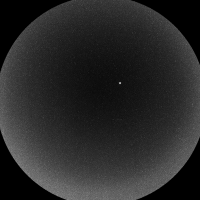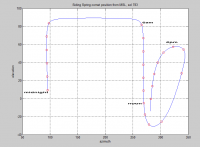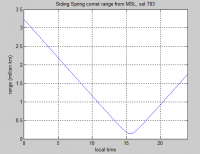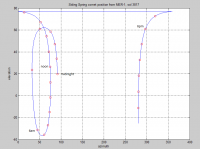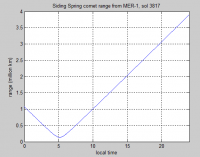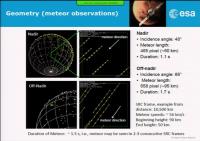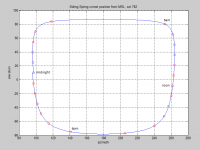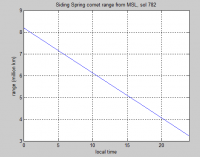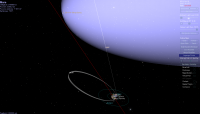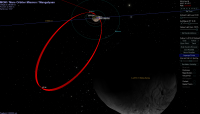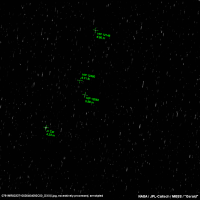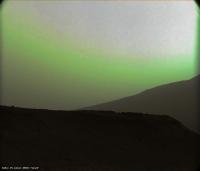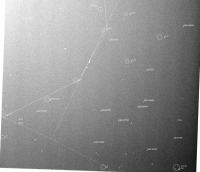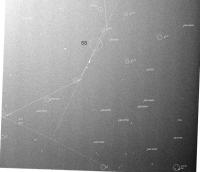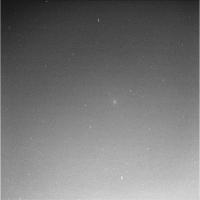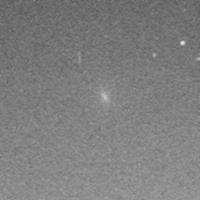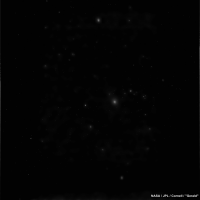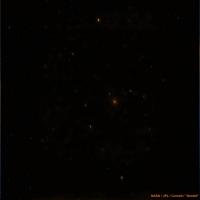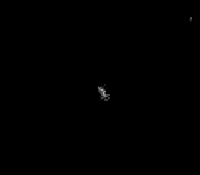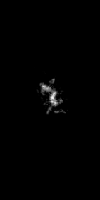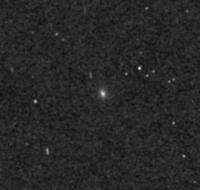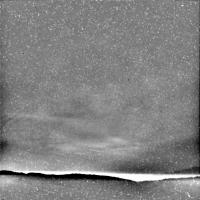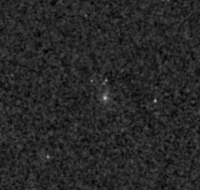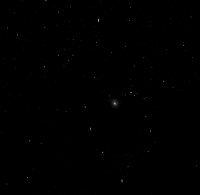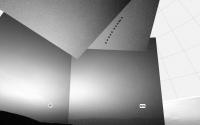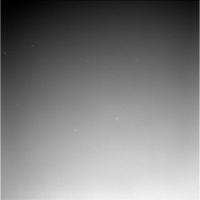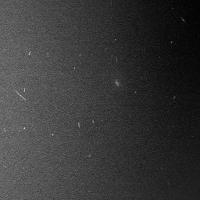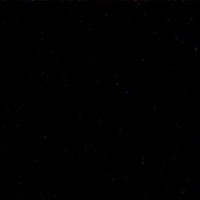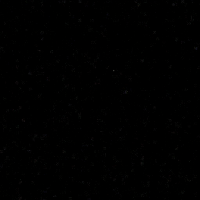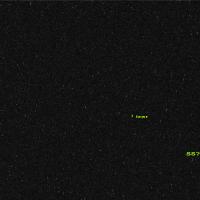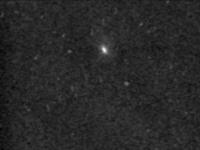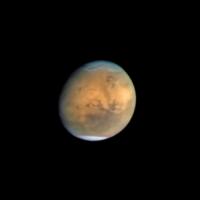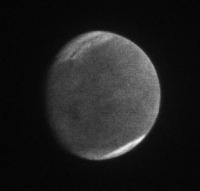Printable Version of Topic
Click here to view this topic in its original format
Unmanned Spaceflight.com _ Telescopic Observations _ Mars Comet Encounter Observations
Posted by: walfy Jul 25 2014, 06:36 PM
http://www.jpl.nasa.gov/news/news.php?release=2014-244&utm_source=iContact&utm_medium=email&utm_campaign=NASAJPL&utm_content=comet20140725 from NASA mentions this possible future observation for the rovers:
"...Rover cameras may be used to observe the comet [Siding Spring] before the flyby, and to monitor the atmosphere for meteors while the comet's dust trail is closest to the planet..."
What are the chances that Deimos or Phobos could get in the shot along with the comet? That would be extraordinarily cool!
Posted by: James Sorenson Jul 26 2014, 03:00 AM
Here is at leased one Opportunity. This one is at 4:06:27 UTC Local Mars Time. on Oct 19. I'm sure there are probably many more opportunity's as well. I'm sure Starry Night isn't that accurate when rendering the approximate tail, coma size and brightness of the comet, but roughly ![]()
https://flic.kr/p/ot44eM
By the way, I'd advise these two posts and further discussions on the comet be moved to the astronomical observations thread.
Posted by: nprev Jul 26 2014, 05:35 AM
Great work, James, and thanks for pointing this out. Hopefully any MER project people who pop in here will take note!
Per your suggestion, this thread will be for observations of this event regardless of the source.
Posted by: JohnVV Jul 26 2014, 05:42 AM
Deimos and Siding Spring on Oct 18 at 00:28 UTC
from Gale
http://www.imagebam.com/image/c707d7341133252
Phobos Oct 18 13:30UTC
http://www.imagebam.com/image/3bef3f341133934
on the 19'th Phobos rises into the tail
http://www.imagebam.com/image/533796341134230
Posted by: nprev Jul 27 2014, 12:36 AM
Nice, John!
I've been looking for magnitude estimates during closest approach with no luck. Understand that this is often a matter of guesswork for comets anyhow, but I calculated around mag -3 from Mars for the coma. Hopefully the tail will be at least that bright per a given unit of area; should be quite a show!
Posted by: JohnVV Jul 27 2014, 12:55 AM
the comet tail above is 100% guessing
that and there is no real good way , right now, to use a real value in celestia
( the tails NEED some recoding in c++ and opengl )
and look at the last comet ( ison)
it was supposed to be GREAT!!!!, and HUGE!!!! ,and mind blowing !!!
then fizzled out on thanksgiving day
Posted by: nprev Jul 27 2014, 01:28 AM
Well, yeah; think that an astronomer once said something like they're 'as unpredictable as cats'. I used what looked to be a middle-of-the-road activity index, and given the extremely close periapsis hoping that -3 is a conservative estimate. Still, we'll have to wait & find out.
Posted by: James Sorenson Jul 27 2014, 01:38 AM
Also great work John ![]() . I agree. It's all guess work with regard to the brightness and how big the comets tail will be. looks like at the time of closest approach, the comet will be below the horizon for Curiosity and Opportunity could be set up to image it. It will be daylight then as well for Oppy. The hours and nights before and after closest approach all look like great imaging opportunity's. At the time of that photo opportunity that I noted, SN gives an estimated -1.07 apparent mag. For Oppy it will be early morning after sunrise at closest approach, SN gives an estimated apparent mag of -8.00. I'd take this figure with a grain of salt and agree with you of a -3.00 or maybe less. I sure hope we are both wrong.
. I agree. It's all guess work with regard to the brightness and how big the comets tail will be. looks like at the time of closest approach, the comet will be below the horizon for Curiosity and Opportunity could be set up to image it. It will be daylight then as well for Oppy. The hours and nights before and after closest approach all look like great imaging opportunity's. At the time of that photo opportunity that I noted, SN gives an estimated -1.07 apparent mag. For Oppy it will be early morning after sunrise at closest approach, SN gives an estimated apparent mag of -8.00. I'd take this figure with a grain of salt and agree with you of a -3.00 or maybe less. I sure hope we are both wrong. ![]()
Posted by: Mongo Jul 27 2014, 04:20 PM
That was David Levy: “Comets are like cats: they have tails, and they do precisely what they want.”
Great, memorable quote, and quite true.
Posted by: Deimos Jul 27 2014, 06:36 PM
No topic like this is complete without a word of caution ![]()
During the morning before closest approach CA (for MER) and the evening after (MSL), the coma is comparable in size to the camera FOV. So the magnitude -5 comet is spread over a million pixels. That's a 15 magnitude downer, if the brightness were uniformly distributed--though it is not. JPL's horizons tool is currently saying around -5 for CA, and the comet has been running sightly brighter than that prediction (as seen from Earth). But the bigger and more impressive it looks in Starry Night, the harder it will be to see anything. Navcam is ~20x less sensitive than MCAM RGB (or Pancam L1 or MAHLI), so wide-field images are not simple. The comet is an AM object inbound, and a PM object outbound. I think people on this forum are familiar with the energy problems associated with the AM side, especially for Opportunity, which would need to skip deep sleep.
That said, various photo ops have been identified, but of course all plans are subject to the tactical operations context at the time--and the dust storm conditions (L_s=218, yikes). But figure the nucleus itself is within a factor of a couple of the size of Deimos, and the comet is maybe 20x further away. So there should be something to see, whether the comet is especially active or not.
Also, of course, cameras in orbit are free of many of the rover's constraints.
Posted by: bkellysky Jul 27 2014, 09:14 PM
The Minor Planet Center
http://scully.cfa.harvard.edu/cgi-bin/returnprepeph.cgi?d=c&o=CK13A010
and
Visual Comets in the Future
http://www.aerith.net/comet/future-n.html
predict about magnitude +8 1/2, as seen from Earth, about the time of closest approach to Mars. Not that our view has much to do with the ability to see the comet from Mars.
I only say this because it would be cool to have Mars and the comet together in the telescope eyepiece and be able to say 'they are actually near each other in space, not just in the sky!' at our monthly star party in October. That's often not the case as you can see with the pairing of planets, and our Moon and stars in August.
Good luck to observers on Earth and on and near Mars!!! It's going be very exciting to see what we can see.
Posted by: mcaplinger Jul 28 2014, 03:12 AM
But come with some significant ones of their own -- they're mostly linescan, with very limited exposure times, and optically not very fast.
I expect that every available instrument will make an attempt, but if no visually spectacular product comes of it, I won't be too surprised.
Posted by: JohnVV Jul 28 2014, 03:48 AM
and on the inbound leg the optics WILL be pointed AWAY from the incoming DUST ( moving at 25,000 KPH )
now on the outbound leg , that is very different
Posted by: machi Jul 28 2014, 10:36 AM
The most interesting of the linescan cameras is undoubtedly HiRISE as it's only camera which has chance to actually photograph nucleus of the comet.
HiRISE has relatively large freedom of exposure times (line times are from 76 microseconds up to at least 67 msec, equivalent exposure time 0.0006 to at least 4 seconds).
Bigger limitation is probably accuracy of spacecraft's pointing (effects of spacecraft pointing jitter and yaw error).
Posted by: Phil Stooke Jul 28 2014, 09:27 PM
They have shown they can deal with that for the Phoenix and MSL parachute descent images, so this should be well within their capabilities. Should be fascinating.
Phil
Posted by: Fran Ontanaya Jul 29 2014, 09:57 AM
Will MEX's VMC be sensitive an wide angle enough to show both Mars and the comet?
They captured Earth two days ago with a 2-30 seconds exposures, so maybe they can expose separatedly to capture the coma and Mars; or if not, just do it when MEX is on Mars' night-side.
Posted by: Gerald Oct 8 2014, 11:32 PM
http://mars.jpl.nasa.gov/msl/news/whatsnew/index.cfm?FuseAction=ShowNews&NewsID=1723
Posted by: djellison Oct 12 2014, 01:47 AM
Not a hard seartch to do....finding this took less time than typing it up.
http://lmgtfy.com/?q=mro+siding+spring
Third hit
http://cometcampaign.org/files/docs/session_4/Tamppari_CSS_CIOC_v3.pdf
Mars Reconnaissance Orbiter Observation Plan for Comet Siding Spring Encounter
Page 5 of which states....
– Observations of the comet near closest approach
• Nucleus size, rotation, shape (estimate => 0.6-1.5 km diameter)
– HiRISE (best resolution ~131 m/pixel)
– CTX (> 3 km/pixel) and CRISM (>10 km/pixel) with also observe
Posted by: Explorer1 Oct 12 2014, 04:47 AM
Basically, we can expect something more like the radar pictures of 2012 DA14 last year than what we've gotten from close flybys. An identifiable shape, but not much else. Plenty of science can come from that alone.
T-minus 1 week....
Posted by: nprev Oct 12 2014, 06:09 AM
I've been searching off & on for a couple of hours but no luck. Anybody know if there's a tau prediction for encounter time for each of the rovers yet? I hear that there are some pretty good localized sandstorms happening mostly in the southern hemisphere, dunno if any of those are expected to blow up into regional events that might affect surface observations on C-sol.
Posted by: scalbers Oct 12 2014, 08:12 PM
http://scully.cfa.harvard.edu/cgi-bin/returnprepeph.cgi?d=c&o=CK13A010
and
Visual Comets in the Future
http://www.aerith.net/comet/future-n.html
predict about magnitude +8 1/2, as seen from Earth, about the time of closest approach to Mars. Not that our view has much to do with the ability to see the comet from Mars.
The current estimate for the brightness seen from Earth on Seiichi Yoshida's site is about magnitude 10.8. A simple distance adjustment would then give magnitude -5.4 seen from Mars. This might change a bit depending on differences in phase angle and whether there is forward or backward scattering in the coma. If the magnitude of the nucleus is 5 magnitudes fainter it would show up as magnitude zero.
Recent images on the same site can be found here, taken from Earth: http://aerith.net/comet/catalog/2013A1/pictures.html. The coma diameter of roughly 1 arcminute seen from Earth would spread out to 28 degrees from Mars at closest approach.
Another good image is here: http://www.universetoday.com/114913/how-to-see-comet-siding-spring-as-it-encounters-mars/
Posted by: Deimos Oct 14 2014, 03:51 AM
Earth-based observers have reported regional dust storms. This is seen at Opportunity's site as optical depths >1; the norm has been around 0.8 according to the MER weather page (http://www.lpl.arizona.edu/~lemmon/mars-tau-b.html). At the 8th Mars conference I saw that, as of that time, MSL and Opportunity optical depths had tracked each other fairly closely. This is pretty close to a time of year when larger (and sometimes much larger) dust storms can emerge.
Posted by: vikingmars Oct 14 2014, 11:01 AM
Today's release is a ChemCam Siding-Spring imaging test : the scientists were to try Chemcam on Sirius (that can be observed in October before sunrise) and on Canopus (that can be observed for 4 hours before sunrise from August to September and which is low on the horizon)... But also at Archenar and at Spica... Do you know which stars they were pointing at ? Enjoy ![]()
http://mars.jpl.nasa.gov/msl/multimedia/raw/?s=777&camera=CHEMCAM_
Posted by: Gerald Oct 14 2014, 12:33 PM
http://astrogeology.usgs.gov/news/astrogeology/sol-775-777-update-on-curiosity-from-usgs-scientist-ken-herkenhoff-weekend-planning.
Here a stitch of four mostly cleaned images:
http://imgur.com/F5y5YR3
Some CR hits are visible, too. I didn't succeed in identifying other stars, yet.
(The pale spot about 188 pixels below Vega is a ghost/camera artifact of Vega.)
Posted by: jmknapp Oct 15 2014, 01:07 PM
Trying to figure out a way to best show the viewing situation on sol 783, the sol of the closest approach, here's a cut at it:
Based on that, looks like the best opportunity is something like 7-10pm, range about one million km (vs. closest approach of 0.14 million km around 3:30pm, just as the comet is rising in the north). I don't suppose there's any chance it would be visible in the daytime? Sunset is 5:31pm.
Posted by: Gerald Oct 15 2014, 02:07 PM
With an albedo of 0.04, a distance of 139,500 km from Mars, a diameter of 0.7 km, and a distance of 1.5 a.u. from the Sun as model assumptions, I get an apparent visual magnitude estimate for the nucleus during closest approach of about 5.6 m: VisualMagnitudeEstimate.pdf ( 41K )
: 596
VisualMagnitudeEstimate.pdf ( 41K )
: 596
For a distance of 1 million kilometers, the magnitude is 2.14 m fainter, hence about 7.8 m with the other assumptions kept the same.
Some Wikipedia links for the notions used:
http://en.wikipedia.org/wiki/Albedo, http://en.wikipedia.org/wiki/Solid_angle, http://en.wikipedia.org/wiki/Magnitude_(astronomy), http://en.wikipedia.org/wiki/Right_triangle, http://en.wikipedia.org/wiki/Moon.
Posted by: fredk Oct 15 2014, 03:41 PM
Thanks a lot, Joe, I was hoping someone would put together plots like that! Any chance you could repeat the elevation-azimuth plot for Oppy?
Posted by: jmknapp Oct 15 2014, 07:18 PM
OK, had to hack that together real quick, hope this is right for Oppy's view of the comet:
Posted by: JohnVV Oct 15 2014, 07:53 PM
for any that want to run the sim and do not already know about this
http://forum.celestialmatters.org/viewtopic.php?f=18&t=578#p10789
i posted a celestia NAIF-spice add on for siding spring
using the HORIZONS database to make the position kernel
( i can not post images at this time - software error do to building VisionWorkbench and StereoPipline )
--- edited later -----
software fixed
Oct 19 at 18:27 UT
[attachment=33988:marsrise.jpg] [attachment=33989:marsrise1.jpg] [attachment=33990:ssm.jpg]
Posted by: Adam Hurcewicz Oct 16 2014, 08:15 AM
http://forum.celestialmatters.org/viewtopic.php?f=18&t=578#p10789
i posted a celestia NAIF-spice add on for siding spring
using the HORIZONS database to make the position kernel
( i can not post images at this time - software error do to building VisionWorkbench and StereoPipline )
I'm made animation from SPICE orbital elements for MEX, Odyssey, MRO, MAVEN, and comet. Also xyzv for MOM from HORIZONS.
That's all in Celestia. I upload to Youtube soon, maybe tonight
I compared precision of simulation from HORIZONS/JPL ephemerides and (for MEX) http://blogs.esa.int/mex/2014/10/15/comet-flyby-timeline/
Posted by: jmknapp Oct 16 2014, 10:18 AM
Mars Express with be using the super resolution channel of the high resolution stereo camera to catch any meteor activity from coma particles:
Posted by: jmknapp Oct 17 2014, 02:16 PM
According to the http://astrogeology.usgs.gov/news/astrogeology/sol-781-update-on-curiosity-from-usgs-scientist-ken-herkenhoff-dumping-sample they'll be trying to image SS on sol 782 as well, the day before closest approach. Here's the viewing situation per http://naif.jpl.nasa.gov/pub/naif/generic_kernels/spk/comets/siding_spring_8-19-14.bsp
Looks like the best chance is in the wee hours at range 7-8 million km, about 50x further away than closest approach on sol 783.
Posted by: Adam Hurcewicz Oct 17 2014, 08:53 PM
https://www.youtube.com/watch?v=9o348MOuu-c
View to Mars, spacecrafts (MRO, Mars Odyssey, Mars Express, MAVEN) rovers (MER-B Opportunity and Curiosity) from comet C/2013 A1
Comet will pass very close to Mars at 18:27:15 UTC (about 135 300 km to planet surface). I have stop for few seconds animation at that time.
At 18:48 UTC Mars will enter path of the comet dust trail
At 20:05 UTC Mars will be at center of the dust trail. Mars Express will try observe meteors on Mars atmosphere
The animation show view from above the comet.
Simple law - comet see the spacecraft = spacecraft see the comet !
About rovers:
Opportunity will see the comet at night to the set comet at morning (18:35 UTC - 10 min after CA)
In the Curiosity sky comet will rise at the daytime and transit at 20:39 UTC (after dusk sky)
This two rovers will have good conditions to see the comet.
Animation are made in Celestia and orbital data are from SPICE/BSP (NAIF/NASA site http://naif.jpl.nasa.gov/pub/naif )
Precision are compared with HORIZONS/JPL ephemerides and ORB files in spk folders.
Posted by: jmknapp Oct 18 2014, 11:15 AM
Nice animation--good to see all the players at once, except the Indian orbiter, which doesn't use SPICE, unfortunately.
Posted by: Adam Hurcewicz Oct 18 2014, 06:48 PM
I have MOM orbital data from HORIZONS but I disable it in this animation.
Here is screen shots with position of MOM at 18:27:15 UTC - 19.10.2014
Posted by: djellison Oct 18 2014, 06:55 PM
It does. If you're being talked to by the DSN and JPL is helping with navigation - believe me - there's SPICE involved. It might not be publicly available - but there IS SPICE data.
If you go into HORIZONS Telnet and ping for MOM - you will see this
--------------------------------------- ----------------- -----------------
131105-131109_od003_v1_dsn 2013-Nov-05 09:53 2013-Nov-05 17:01
131105-131109_od005_v1_dsn 2013-Nov-05 17:01 2013-Nov-06 20:22
131106-131111_od008_v1_dsn 2013-Nov-06 20:22 2013-Nov-07 21:27
131107-131111_od011_v1_dsn 2013-Nov-07 21:27 2013-Nov-08 21:16
131108-131113_od013-newEBN4_v1_dsn 2013-Nov-08 21:16 2013-Nov-09 22:31
131108-131112_od014_v1_dsn 2013-Nov-09 22:31 2013-Nov-10 00:01
131110-131113_od017_v1_dsn 2013-Nov-10 00:01 2013-Nov-10 21:29
131110-131114_od018_v2_dsn 2013-Nov-10 21:29 2013-Nov-12 00:01
131112-131130_od022_v1_dsn 2013-Nov-12 00:01 2013-Nov-15 20:20
131115-131211_od032_v1_dsn 2013-Nov-15 20:20 2013-Nov-25 13:01
131125-140926_od033_v1_dsn 2013-Nov-25 13:01 2013-Nov-30 20:01
131130-140926_od041_v1_withTCM1_dsn 2013-Nov-30 20:01 2013-Dec-11 09:56
131211-140926_od090_v1_dsn 2013-Dec-11 09:56 2014-Feb-19 04:01
140219-140926_od170_v1_dsn 2014-Feb-19 04:01 2014-Apr-15 02:01
140415-140926_od205_v1_dsn 2014-Apr-15 02:01 2014-Jul-26 22:31
140726-150925_od222_v1_MOI 2014-Jul-26 22:31 2014-Sep-24 02:15
140924-141024_od227_v1_dsn 2014-Sep-24 02:15 2014-Sep-27 01:41
140927-141029_od230_v1_dsn 2014-Sep-27 01:41 2014-Sep-30 03:46
140930-141125_od232_v1-PHASEMVR_JPL 2014-Sep-30 03:46 2014-Oct-03 22:21
141003-141107_od235_v1_dsn 2014-Oct-03 22:21 2014-Oct-12 20:16
141012-141115_od237_v1_dsn 2014-Oct-12 20:16 2014-Nov-15 12:01
That's all filenames of SPICE BSPs
Doug
Posted by: jmknapp Oct 18 2014, 09:40 PM
I was going by this from a http://naif.pds.nasa.gov/naif/SPICE_News_August_2013.pdf from last year:
For ISRO's moon orbiter I found this https://wufs.wustl.edu/meetings/NAIF_Status_8-10_R1.pdf from NAIF
– Poor SPICE ops on Chandrayaan-1
» Much good data cobbled together by M**3 team
» No sign of an archive so far
Maybe the files are from another source than ISRO?
Posted by: fredk Oct 18 2014, 10:51 PM
I think the new 781 mastcam observations are the first of the SS field. All I could see is a faint trail on one of the frames, in the lower-left quadrant:
The orientation is about right for a star trail at that azimuth/elevation. Considering how faint the comet should still be, this is likely just a star.
Posted by: Gerald Oct 18 2014, 11:20 PM
It's probably http://en.wikipedia.org/wiki/Pi_Eridani, sorry meant http://en.wikipedia.org/wiki/Pi_Ceti, just outside Eridanus. There may be some more stars hidden in the noise. The pointing is good, but I couldn't identify the comet thus far. I'll try to identify the star(s), and edit this post later with more stars identified, if possible.
Here an excessively processed and tentatively annotated version of the Sol 781 Pi Ceti image:
Posted by: djellison Oct 19 2014, 12:46 AM
Let me put it another way. The DSN is using SPICE data generated by JPL nav team. We use the exact same SPICE data in Eyes on the Solar System. That same SPICE data is driving anything people get from HORIZONS.
Posted by: JohnVV Oct 19 2014, 01:23 AM
i think the issue is that there are no naif ck and spk folders for "mom "
like there is for, say Cassini.
ftp://naif.jpl.nasa.gov/pub/naif/CASSINI/kernels/ck/
ftp://naif.jpl.nasa.gov/pub/naif/CASSINI/kernels/spk/
but the data in horizons is current just in a different form
Posted by: djellison Oct 19 2014, 01:27 AM
I know that. But it's still SPICE that's driving HORIZONS. The same SPICE driving 'Eyes..' and telling the DSN where to point.
Posted by: Deimos Oct 19 2014, 02:11 AM
Opportunity also imaged Pi Ceti during a test run a few sols ago. In addition to increased extinction, the distant dust storms make for an annoyingly bright twilight. http://mars.nasa.gov/mer/gallery/all/1/p/3812/1P466564406EFFCHYOP2664L1M1.JPG
Posted by: nprev Oct 19 2014, 06:51 AM
Haven't seen this posted yet. Emily has a nice summary of real-time telescopic webcasts & other resources in her most recent http://www.planetary.org/blogs/emily-lakdawalla/2014/10171350-watching-siding-springs.html.
Posted by: Gerald Oct 19 2014, 12:01 PM
There are rather impressive Sol 782 night shots. Here a brightness-stretched and denoised ML image:
Posted by: jmknapp Oct 19 2014, 12:17 PM
I think the sol 782 images taken around 4:08am, elevation 70 degrees, azimuth 100 degrees are the ones with SS in frame, if visible, e.g.,
http://mars.jpl.nasa.gov/msl-raw-images/msss/00782/mcam/0782MR0033730040404149C00_DXXX.jpg
http://mars.jpl.nasa.gov/msl-raw-images/msss/00782/mcam/0782MR0033730030404148C00_DXXX.jpg
http://mars.jpl.nasa.gov/msl-raw-images/msss/00782/mcam/0782ML0033730050400344C00_DXXX.jpg
Based on the ML shots, seems there was quite a bit of sky brightness in the east around 4:10am, a little over an hour before sunrise:
http://curiosityrover.com/synth/?camera=ML&station=246
Posted by: Gerald Oct 19 2014, 12:46 PM
A preliminary stitch of three of the Sol 782 ML images:
http://imgur.com/bUzmuCeThe shape of the comet begins to become more apparent. (Wishful thinking, see next post.)
Posted by: mhoward Oct 19 2014, 12:59 PM
Uh... no. That's got to be just pre-dawn illumination of the sky.
Those pictures have been on the ground over 24 hours. If that were the comet, that image would right now be plastered all over media around the world.
Posted by: Cosmic Penguin Oct 19 2014, 04:02 PM
Sorry if I sounds like an orbital mechanics rookie, but what are the closest approach distances of the 5 Mars orbiters to the comet? ![]()
Posted by: Adam Hurcewicz Oct 19 2014, 04:36 PM
comet - MOM - 88 222 km at 18:14 UTC
comet - MRO - 135 750 km at 18:28 UTC
comet - MEX - 136 890 km at 18:26 UTC
comet - Odyssey - 141 140 km at 18:26 UTC
comet - MAVEN - 143 290 km at 18:26 UTC
Posted by: Deimos Oct 19 2014, 08:10 PM
As Joe said, the comet was up at 70 deg when the twilight images happened. The sky was brighter than any comet has ever been at 1.5 AU from the Sun.
The latest predictions (i.e., what I see in Starry Night - 2 magnitudes, per http://cometcampaign.org/current-status) suggest the comet may total 100X as bright as M31, outside of twilight, at a time when its coma has >5X the angular extent: so the light is diluted to <20X M31. If you've seen previous attempts to image M31 (http://www.unmannedspaceflight.com/index.php?s=&showtopic=7238&view=findpost&p=185599 and http://www.unmannedspaceflight.com/index.php?s=&showtopic=7730&view=findpost&p=203306) in less dusty conditions, then you have an appropriate sense of how bright the comet may appear.
Opportunity's night is done, but it is a long wait for a relay pass. Curiosity should get to work soon, but again it will be a long wait.
Posted by: nprev Oct 19 2014, 08:18 PM
Thanks very much for the update, Deimos.
I've seen unconfirmed reports that the coma is greater in extent than anticipated (though no means for determining that was specified; presuming it was via Earth-based telescopes, but I'd think that the glare from Mars would complicate that). Does anyone have any reliable information regarding this, or anything else of interest for that matter?
EDIT: Found a http://mars.nasa.gov/comets/sidingspring/ for US orbiter status post-passage. Not particularly informative at the moment; all statuses are 'pending'.
Posted by: scalbers Oct 19 2014, 08:26 PM
Just to shuffle these numbers a bit, current magnitude would be about 11.5 from Earth, translating to -4.7 from Mars at closest approach. If M31 is 3.5 magnitude, then SS is about 2000 times as bright. If SS has 5 times the angular diameter as M31, then the areal extent is 25x. Thus the surface brightness would be 80x that of M31.
Seen from Earth, an image 8hrs before closest approach from comets-ml is here where it looks pretty well condensed in an area smaller than 1 arcminute, with the overall coma being around 1 arcminute: http://www.dpreview.com/galleries/4594584079/photos/3051425/comet-c-2013-a1-approaching-mars?inalbum=comets
Via Twitter today is this pretty neat color image: http://cf.tzecmaun.org/2014/10/mars-and-comet-c2013-a1-siding-spring/
An Oct 17th visual description is here: https://groups.yahoo.com/neo/groups/CometObs/conversations/topics/5852
Posted by: fredk Oct 19 2014, 08:50 PM
Thanks for identifying the field. This image shows the stars I identified in the two frames:
http://mars.nasa.gov/mer/gallery/all/1/p/3812/1P466564386EFFCHYOP2664L1M1.JPG
http://mars.nasa.gov/mer/gallery/all/1/p/3812/1P466564406EFFCHYOP2664L1M1.JPG
Noise subtraction doesn't help very much with these frames, probably due to the high sky brightness. But it's pretty easy to ID the stars by flipping between the two frames and matching the faint streaks in the longer exposure with the points in the shorter exposure. Here's the result, with identified stars circled:
I've superimposed a star map, slightly shifted to the right, so you can see that the identifications are good. There's nothing unexpected here, except the uppermost circled point, which I'm guessing is a star just below the magnitude limit of my map (though someone should check this). It would be nice to know the location of SS when these images were taken, though...
On the (slightly) plus side, tau was 1.19 on 3812, when these images were taken. The latest values are slightly better, 1.07 for 3815.
Edit: The faintest identifiable stars in my image are about 6th magnitude, at least in the darker part of the frame.
Posted by: Explorer1 Oct 19 2014, 08:58 PM
According to DSN Now everything went well Maven, MRO, Mars Express, and Odyssey. Communications going on just fine...
Posted by: nprev Oct 19 2014, 09:14 PM
As expected. It'll be interesting to see if there have been any effects at all on any of the spacecraft.
Posted by: Gerald Oct 19 2014, 10:04 PM
That's probably the variable star http://simbad.u-strasbg.fr/simbad/sim-id?Ident=V*+Z+Eri, mag. 6.79, according to Redshift 7 software, as far as this can be said for variable stars.
Posted by: nprev Oct 19 2014, 10:41 PM
http://mars.nasa.gov/news/whatsnew/index.cfm?FuseAction=ShowNews&NewsID=1734 MRO's fine & successfully maneuvered for all planned observations.
Posted by: JohnVV Oct 19 2014, 11:43 PM
for image
http://mars.nasa.gov/mer/gallery/all/1/p/3812/1P466564386EFFCHYOP2664L1M1.JPG
and image
http://mars.nasa.gov/mer/gallery/all/1/p/3812/1P466564406EFFCHYOP2664L1M1.JPG
[attachment=34022:386EFFCH...2664L1M1.jpg] [attachment=34023:4406EFFC...2664L1M1.jpg]
Posted by: jmknapp Oct 20 2014, 12:16 AM
I get RA 02:44:15, dec -15.25 for SS at the time of those images--can you place it on your diagram from that?
Posted by: JohnVV Oct 20 2014, 12:49 AM
some sim images
Comet rise then set for Curiosity
rise at about 14:20 UT , then set will be at about 22:30
http://imgbox.com/DwYXFwLt http://imgbox.com/MfP5h27r
https://plus.google.com/u/0/photos/102695901291398562941/albums/6072078138374025457/6072078141990992834?pid=6072078141990992834&oid=102695901291398562941
https://plus.google.com/u/0/photos/102695901291398562941/albums/6072078138374025457/6072078145988026242?pid=6072078145988026242&oid=102695901291398562941
for Opportunity
Comet rise as of a few min. ago 20:25 and it will set at about 7:00 UT Oct.20
http://imgbox.com/p6jk4S5D http://imgbox.com/2t0vMaH5
https://plus.google.com/u/0/photos/102695901291398562941/albums/6072078138374025457/6072078145374466034?pid=6072078145374466034&oid=102695901291398562941
https://plus.google.com/u/0/photos/102695901291398562941/albums/6072078138374025457/6072078153065408226?pid=6072078153065408226&oid=102695901291398562941
image folder
https://plus.google.com/u/0/photos/102695901291398562941/albums/6072078138374025457
Posted by: Deimos Oct 20 2014, 12:52 AM
Using the new HiRise-based solution 101 at Horizons, I got ~1/3 of the way from Pi Cet toward Tau1 Eri as a presumed location.
Posted by: fredk Oct 20 2014, 12:54 AM
Yeah, that agrees with Joe's coordinates. I've circled the location with a large circle here:
(Circle position drawn for pancam image, not star map, which is offset.)
Nothing obvious there...
Posted by: James Sorenson Oct 20 2014, 12:57 AM
Just before sunrise, taken around 4:20 AM on Sol782 in an attempt to capture Comet Siding Spring. ![]()
![]()
EDIT (10/22/2014): I updated the mosaic to further remove the noise in the scene.
https://flic.kr/p/pGxmaQ
Posted by: vikingmars Oct 20 2014, 06:58 AM
Thanks James for this very nice mosaic.
Definitely, early morning pictures are worth to see.
They sould be taken more oftenly by MSSS and JPL (with their NavCams) for us to help build spectacular panoramic pictures for EPO...
Posted by: vikingmars Oct 20 2014, 07:46 AM
Here is comet Siding-Spring spotted by the Opportunity rover in the Martian sky ! (pictures are just de-noised) :
http://qt.exploratorium.edu/mars/opportunity/pancam/2014-10-20/1P467007331EFFCH0HP2665L1M1.JPG
Enjoy !
Posted by: Adam Hurcewicz Oct 20 2014, 08:35 AM
Great ! What time of capture is it ?
Posted by: jmknapp Oct 20 2014, 09:32 AM
Capture time based on et in the filename is 2014OCT19 16:14:24 UT.
The local time was about 3am. The comet was at maximum elevation (60 degrees), range about 400,000 km. Closest approach (~140,000 km) was a couple hours later, after the comet had set. So this perhaps was the best chance and they nailed it.
Posted by: Gerald Oct 20 2014, 11:46 AM
An attempt to enhance the Siding Springs comet in the Oppy image:
Edit: This image fuses comet enhancement and star enhancement into one false-color image (comet reddish, stars bluish) :
Posted by: fredk Oct 20 2014, 02:27 PM
The structure you're seeing in that extreme zoom is almost entirely jpeg and other noise...
Here's my best shot at the longer exposure. Bandpass up to 4 pix and down to 100 pix, with horizontal stripe suppression, followed by a linear stretch trying not to loose information:
You can see pretty clearly (especially by comparing to the shorter exposure) that the comet's motion during the exposure is at a different speed and direction than the stars in the field - that's the sign of a very close comet!
Posted by: neo56 Oct 20 2014, 02:34 PM
My take at the MC34 mosaic taken at dawn. Noise was removed manually with GIMP for the surface (it was quite a long work) and with a filter for the sky.
https://flic.kr/p/pK46Dn
Posted by: fredk Oct 20 2014, 02:37 PM
Here's a similar treatment (bandpass, stretch) on one of the MSL navcam frames. The pointing is not correct yet (the three navcam frames show the same pointing), so I don't know if this was meant to image SS or not (actually I think SS would have been higher than this frame shows). Nevertheless I'll post it in this thread. It shows some clouds near the horizon:
Posted by: alex_k Oct 20 2014, 02:50 PM
I experiment with a very special kind of Fourier processing. It's interesting. can it be used for hyperresolution purposes. The results are uncertain.
Posted by: fredk Oct 20 2014, 03:07 PM
Illustrating my point about the different motions of SS and the stars, a flicker gif between the two (similarly processed) frames.
You can see the 4 or 5 stars rising in the east, but SS moving to the left (north) relative to the stars. This agrees with the SS path for Oppy's sky from Joe.
The tau rose up to 1.24 on 3817 according to http://www.lpl.arizona.edu/~lemmon/mars-tau-b.html
Posted by: Gerald Oct 20 2014, 03:17 PM
One more version of the Sol 783 NRB, cleaned, and averaged with three different cleaned hipass (radius 50, 100, 200 pixels) versions:
http://imgur.com/tCWMDQT
Posted by: James Sorenson Oct 20 2014, 07:16 PM
Lovely work Thomas on your version! In a sense, I love the noise since it's a challenge to sometimes remove completely, it toughens the image processing skills.
Posted by: jmknapp Oct 20 2014, 07:37 PM
Who knew Mars could be moody?
Posted by: elakdawalla Oct 20 2014, 09:44 PM
http://www.midnightplanets.com/web/MSL/sol/00783.html. I didn't see a comet in my first pass through them -- can any of you find it?
http://www.nasa.gov/jpl/mer/nasa-rover-opportunity-views-comet-near-mars/
Posted by: machi Oct 20 2014, 10:06 PM
I tried to look if the Oppy's image shows Siding-Springs' tail but it probably doesn't.
But it shows coma on this denoised image.
Posted by: Adam Hurcewicz Oct 20 2014, 10:10 PM
Why images have view to Az = 105 deg and El = 5 deg ? at this time ?
Comet should be at elevation 50-54 deg and azimuth 300-310 deg !
Posted by: nprev Oct 20 2014, 10:25 PM
Shooting from the hip, I'd guess that az/el is referenced to the camera's boresight with respect to the rover & not Martian true north or the horizon...?
Posted by: fredk Oct 20 2014, 10:35 PM
We've seen temporary incorrect coordinates before. They'll hopefully be updated soon.
I see no sign of a tail in the release images, but maybe a hint of elongation away from the sun.
Posted by: Explorer1 Oct 20 2014, 11:55 PM
What we've all been waiting for:
http://www.uahirise.org/releases/siding-spring/
The small size gives the 'comets start out bright and turn black with time' hypothesis some validity. From pristine snowball to a lump of coal (though not this one; probably never coming back again after perihelion?)
Posted by: mhoward Oct 20 2014, 11:56 PM
Was that it? I guess it must have been. Here they are in context. Several minutes between images.
Posted by: fredk Oct 21 2014, 01:01 AM
Accoding to http://astrogeology.usgs.gov/news/astrogeology/sols-785-786-update-on-curiosity-from-usgs-scientist-lauren-edgar-comet-siding-spring
Not clear if that simply means the images were taken, or if it means that in (some of) the images the comet was visible. There doesn't seem to be any sign of the comet in the jpegs of the navcam or chemcam images downlinked yet.
Posted by: dvandorn Oct 21 2014, 01:49 AM
HiRISE got it.
http://www.jpl.nasa.gov/spaceimages/details.php?id=PIA18618
-the other Doug (With my shield, not yet upon it)
ps -- and now I see I was scooped by two hours. Sigh. Gotta get off these painkillers, dammit...
Posted by: Explorer1 Oct 21 2014, 01:57 AM
It's alright Doug! I wasn't particularly coherent myself after a wisdom tooth got pulled... ![]()
So in terms of image data, all that's left for release is from Mars Express, correct? All the spectra, dust flux, and other non-imagery results from other spacecraft will be at the December conference?
Posted by: dvandorn Oct 21 2014, 02:00 AM
Wasn't MOD looking for shooting stars in Mars' night atmosphere? I haven't seen anything from that, yet, either. (Of course, the raw jpegs might not show a whole lot on this, it might take some real heavy image processing to find those.)
-the other Doug (With my shield, not yet upon it)
Posted by: vikingmars Oct 21 2014, 08:54 AM
Not clear if that simply means the images were taken, or if it means that in (some of) the images the comet was visible. There doesn't seem to be any sign of the comet in the jpegs of the navcam or chemcam images downlinked yet.
Agree with you. When I saw the Navcams taken Sol 783 at late evening, my 1st reaction was : it was a foggy night ! Maybe some fog was there over Gale crater. My Viking experience tells me that when there is fog over you on Mars, there is little chance to see any moons or stars in the night sky. We had some nighttime Phobos imaging experiments done in 1977 showing this...
Posted by: paraisosdelsistemasolar Oct 21 2014, 09:15 AM
This image from Opportunity just showed up from the 19th of October:
Are all of these cosmic ray impacts? Or could some be meteors?
Also, a new observation of Siding Spring is avaiable:
Posted by: Gerald Oct 21 2014, 10:57 AM
Sequence of cleaned and 4x-brightened MSL Sol 783 MastcamLeft images:
A dot is jumping around. Might be the comet, but I'm not yet quite sure.
Edit: It's probably the star Izar (Epsilon Boötis).
Edit: Here the corrected order:
Posted by: jmknapp Oct 21 2014, 11:07 AM
Trying my hand at identifying stars in the noise (hats off to those who do this routinely), I think I identified Epsilon Boötis (aka Izar) in http://mars.jpl.nasa.gov/msl-raw-images/msss/00783/mcam/0783MR0033840030204197C00_DXXX.jpg and find a potential candidate for Siding Spring:
Izar is at RA/dec 14:44:59/27.07 and SS per the August SPICE file was at 14:45:47/25.19. The candidate for SS isn't quite at that location, but the report from HiRISE was that SS wasn't in the predicted position exactly.
Posted by: James Sorenson Oct 21 2014, 11:33 AM
I'd say these are good candidates for the comet ![]()
https://flic.kr/p/oNWLWM
https://flic.kr/p/pKvy3D
Posted by: Gerald Oct 21 2014, 01:37 PM
Checking it forth and back, I think the streaks (and smaller spots in low-exposure images) are all Izar (Epsilon Boo).
Izar has been well visible in earlier images. All kinds of cleaning, enhancement, registering, stacking I've been trying thus far revealed nothing else than noise, hot pixels and other camera artifacts, and the likely Izar. Things seem to be even more subtle; accurate stacking of the comet position, including rotation - once it's known - may help.
Edit: Identified at least 34 W Boo in http://mars.jpl.nasa.gov/msl-raw-images/msss/00783/mcam/0783MR0033780030204181C00_DXXX.jpg:
http://imgur.com/STJrUTu
Posted by: Phil Stooke Oct 21 2014, 04:11 PM
Playing with the HiRISE images a bit. I was disappointed not to get more pixels across the nucleus (i.e. I hoped they had previously underestimated its size rather than overestimated it) but reality intervenes once more (darn it). Still... I expect a rough shape will be determined from this, and maybe one or more specific active regions will be identified.
Phil
Posted by: elakdawalla Oct 21 2014, 04:18 PM
I asked Alfred what the phase angle was, and he said 110 degrees. So there's significant unilluminated comet nucleus in the photo, and coma is bright from forward scattering.
Posted by: climber Oct 21 2014, 05:01 PM
Any body has more information about this picture showing on spaceflightnow?
http://www.spaceflightnow.com/news/n1410/20sidingspring/sidingspring_large.jpg
Posted by: djellison Oct 21 2014, 05:04 PM
It's the same HiRISE imagery we've been talking about here since yesterday
http://www.jpl.nasa.gov/spaceimages/details.php?id=PIA18618
Posted by: fredk Oct 21 2014, 05:40 PM
Here's a quick-and-dirty (done while traveling) average of four of the best 50 second pancam exposures. As before, bandpass filtered followed by stretches, before registering on the comet and averaging:
Note the four short vertical dashes extending to the lower left of the comet - that's a star, showing its large relative motion to the comet (or comet to star).
I would now pretty confidently say a faint extension of the coma is visible upwards, which corresponds roughly to the antisun direction.
S/N could be improved a bit by incorporating more frames.
Posted by: brellis Oct 21 2014, 08:45 PM
Q for the better minds here: Was the trajectory of the comet's orbit greatly affected by the Mars encounter?
Posted by: James Sorenson Oct 21 2014, 11:31 PM
Like the sunrise sequence that was acquired on Sol-782, this one is another that I'm looking forward to when the full's come down. Here is a thumbnail preview of it just after sunset on Sol-783 during the comet imaging campaign. ![]()
https://flic.kr/p/oPjcyG
Posted by: fredk Oct 21 2014, 11:40 PM
Better or worse, I'll take it!
At the comet's closest-pass distance of about 140 000 km, the Mars orbital velocity would be about 0.55 km/s. In other words, the trajectory of any object at that distance from Mars and moving at that speed would be substantially affected by Mars (it would be in orbit, if the velocity was in the right direction). Ie, affected at something like the 100% level.
But SS whizzed by at around 56 km/s, which is around 100 times faster than the orbital velocity. So I would estimate that the path of SS was altered at very roughly the 1% level by its encounter with Mars, in other words hardly at all.
Good question!
Edit: Gerald adds a good point: a small (1%) change can have a huge effect over the full orbit of the comet. Orbits can be chaotic, with extreme sensitivity to small changes over long enough timescales.
Posted by: Gerald Oct 21 2014, 11:47 PM
In the long run:
For an Oort object like C/2013 A1 even a small delta-v as provided by the rudimentary http://en.wikipedia.org/wiki/Gravity_assist makes a difference. In the current case it seems to slow down the comet a little bit, enough to reduce the orbital period down to a fraction (from "several millions years" to about 1 million years, according to http://en.wikipedia.org/wiki/C/2013_A1, which refers to http://ssd.jpl.nasa.gov/horizons.cgi?find_body=1&body_group=sb&sstr=2013A1). I'd think, Jupiter will also play some role, but I don't know the respective numbers.
Posted by: James Sorenson Oct 22 2014, 12:21 PM
The Sol-783 Sunset mosaic ![]() .
.
Starry Night shows that comet siding spring should be at the very top of the mosaic. I have identified two candidates. There is one faint dot at the very top-left edge of the mosaic which could also be the comet or could also be an artifact or something else...?
https://flic.kr/p/pu5cGK https://flic.kr/p/pLvsqe
Annotated
Posted by: vikingmars Oct 22 2014, 03:39 PM
Thanks so much James !
What a GREAT image.
I would like MSSS to take more oftenly some color panoramic pictures like this after sunset (maybe showing a little more of the surface at the foreground) : they would be great for EPO.
The subtle blue hues makes you feel you are right there on Mars staring at the night sky !
Posted by: Gerald Oct 23 2014, 03:22 AM
The nature of the dots is hard to tell with certainty. The faint one looks like a jpg-artifact near a hot pixel. The bright one looks more like a CR hit.
There should be several pretty bright stars in the mosaic. But I wasn't able to identify them, since the twilight has been rather bright during dusk.
The comet should have crossed the region between half an hour and an hour later, assuming the timings for the ChemCam takes on http://curiosityrover.com/synth/?camera=ML&station=246 correspond to the apparent motion of the comet.
That's the hypotheses I'm currently going to check:
http://imgur.com/Tjs4u0s http://imgur.com/1hhsjRr
The images have been obtained by combining and enhancing cleaned (by subtracting darkest of a pair of rad-20 hipast images) Sol 783 ML with the synchronously taken according cleaned and enhanced MR image (7:11:32 and 7:34:17 p.m. LMST). The idea is exploiting different kind of noise for ML and MR. Enhancement ideas have been a specific linear operator (five (-1,-1,1,2,1,-1,-1) lines after rotating the image such that star streaks are pointing vertically), and combining a displaced (by 6 pixels, to stay independent of the linear operator) copy of the image. ML and MR images have been combined by choosing the darkest pixel of resized (ML enlarged by 100/34) and registered (by Izar) images, and subsequent brightness stretch; the idea has been to use the lower end of the Gauss bell curve as an indication of a signal level above noise.
The HIP-stars marked with '?' aren't yet checked for exactly matching positions.
The green marks are comet candidates.
If the tentative identification of the "HIP" stars turn out to be correct, some features fainter than mag. 8 should be feasible, and Siding Spring within reach.
Edit: I couldn't confirm the detection of stars fainter than about mag. 5 in processed 0783MR0033840030204197C00_DXXX.jpg.
Posted by: Burmese Nov 2 2014, 01:32 AM
So any more observations of the comet still to roll in? So far Oppy and the HiRise seem to be the only two that successfully tagged it.
Posted by: mcaplinger Nov 2 2014, 04:50 AM
You may have to wait for the PDS data releases for some of them.
Posted by: jmknapp Nov 2 2014, 10:58 AM
How about ESA/MEX?
Posted by: Phil Stooke Nov 2 2014, 02:41 PM
Here is the CRISM view:
http://mars.nasa.gov/news/whatsnew/index.cfm?FuseAction=ShowNews&NewsID=1743
Phil
Posted by: Paolo Nov 3 2014, 02:05 PM
here you go! Siding Spring from the HRSC on MEX
http://dlr.de/dlr/en/desktopdefault.aspx/tabid-10081/151_read-11946/year-all/#/gallery/16991
Posted by: Deimos Nov 6 2014, 04:57 AM
MSL/Mastcam: http://mars.nasa.gov/comets/sidingspring/images/?ImageID=6725
Posted by: Explorer1 Nov 6 2014, 05:19 AM
Very nice! The contrast with the comet in the big banner up top couldn't be more stark though (I'm not blaming the poor intern who had to do it!)
Posted by: nprev Nov 6 2014, 08:07 AM
Great! Deimos, what was the 'guide star' (the bright streak)?
Posted by: Gerald Nov 6 2014, 12:58 PM
That's Izar, and a little fainter at the lower left of Izar, http://en.wikipedia.org/wiki/34_Bo%C3%B6tis.
(Good to know, that I haven't been too far away a few posts above.)
Really good work of the team members, who planned the takes, and those, who brought it out this clear, despite the challenging conditions. Congrats! ![]()
Posted by: jmknapp Nov 6 2014, 01:45 PM
Must have taken a lot of massaging, denoising, etc. I looked at the raw images in the timeframe cited (sol783) and don't see much of anything in the JPGs.
Posted by: Gerald Nov 6 2014, 02:20 PM
It's no way easy, even after a couple of routine cleaning and enhancement steps:
http://imgur.com/d6wiFgQ
Izar is clearly visible after subtracting hot pixels, but then it's going to get increasingly sophisticated.
JPG compression of the available images may be a (poor?) excuse. Fortunately they took some lossless images; not sure, whether it has been much easier with the latter.
Posted by: 4th rock from the sun Nov 6 2014, 02:51 PM
If you have dark and bias fields all that noise goes away like magic ![]()
Posted by: Explorer1 Nov 6 2014, 10:13 PM
Telecon with first results tomorrow morning:
http://www.jpl.nasa.gov/news/news.php?feature=4362
Posted by: fredk Nov 7 2014, 05:05 PM
Here's a very quick and dirty attempt at stacking 8 of the press release mastcam images:
I've done a 2pix Gaussian blur to reduce noise. Definitely some coma visible.
Posted by: CPAero Nov 7 2014, 08:56 PM
Hi all, long time reader and big fan of all the image processing and discussion that goes on in these forums. I haven't yet found a treatment of the following sequence of MSL M100 sub-frames in these forums or elsewhere, and I would love to see what you guys/gals can do with this set. The comet is first visible in 0783MR003377 at row 282, col 565, and scoots toward lower right in successive frames. Forgive me if this sequence has already been discussed.
http://mars.jpl.nasa.gov/msl-raw-images/msss/00783/mcam/0783MR0033770000204176E01_DXXX.jpg
http://mars.jpl.nasa.gov/msl-raw-images/msss/00783/mcam/0783MR0033780020204180E01_DXXX.jpg
http://mars.jpl.nasa.gov/msl-raw-images/msss/00783/mcam/0783MR0033790000204182E01_DXXX.jpg
http://mars.jpl.nasa.gov/msl-raw-images/msss/00783/mcam/0783MR0033800000204184E01_DXXX.jpg
http://mars.jpl.nasa.gov/msl-raw-images/msss/00783/mcam/0783MR0033810020204188E01_DXXX.jpg
http://mars.jpl.nasa.gov/msl-raw-images/msss/00783/mcam/0783MR0033820000204190E01_DXXX.jpg
http://mars.jpl.nasa.gov/msl-raw-images/msss/00783/mcam/0783MR0033830000204192E01_DXXX.jpg
http://mars.jpl.nasa.gov/msl-raw-images/msss/00783/mcam/0783MR0033840020204196E01_DXXX.jpg
Cheers
-Ryan
Posted by: nprev Nov 7 2014, 10:49 PM
Apparently there may have been quite a meteor shower associated with passage of the comet. Unfortunately, the rovers aren't equipped to observe such an event:
http://www.nytimes.com/2014/11/08/science/space/bright-specks-of-comet-dust-light-up-martian-sky.html?_r=0
Posted by: Explorer1 Nov 7 2014, 10:54 PM
Yes, it was mentioned in the telecon this morning, along with a possible bright yellow glow in the night sky (from the sodium in the coma). The human eye would be far more subtle a detector than any mechanical camera, they mentioned.
Posted by: Gerald Nov 8 2014, 12:51 AM
That's the only moving object visible without image processing. Difficult to see in a single raw image. But it's not the comet, it's Izar, the bright streak in the released processed MC images.
The comet is really subtle, maybe even more subtle than 34 W Boötis, which can be made visible, too.
Posted by: fredk Nov 8 2014, 03:56 PM
I heard part of that but there seemed to be contradictory statements - someone said it would've been a spectacular show from the ground, but I thought someone also said the meteor particle sizes would've been very tiny, like dust, so you may not have seen many meteors. In other words, there was lots of fine dust coming in, rather than particles of typical naked-eye meteor size on Earth. Did anyone get a clearer picure of this from the conference?
Either way, I was surprized that they saw such an obvious effect in terms of ionized metals etc.
Posted by: MahFL Nov 8 2014, 11:10 PM
They said you may have seen 1000's of meteors per hour, for about 90 minutes. 1000's....
Posted by: elakdawalla Nov 9 2014, 04:45 AM
That was one of the bits of the conference where there may have been a little disagreement on the panel. It was Nick Schneider saying there would've been a couple of tons of material entering Mars' atmosphere, which would result in a 1000s of meteors per hour storm. I forget who commented later about the particle size being smaller.
Posted by: Deimos Nov 9 2014, 09:47 PM
If the 1-3 mm size predictions were right (http://cometcampaign.org/tony/orbiter-results), the 'storm' would have produced a lot of meteors bright enough for normal human vision in dark skies, and many could have been bright enough for one of the rovers to see (in dark skies). If it had been partitioned into 1 g chunks, the rovers' cameras could have seen 1 every few minutes. If smaller, then it could have been human-visible but not visible to the current rover cameras (that's one area the sensitivities are not similar). But of course the prime reasons the rovers couldn't have seen it are not instrumental: daylight and (for MSL) 1000s of km of Mars.
Given the high speeds, the meteors might have become daytime visible (to a person) at a few grams, but short exposure times would have meant that 1000s of images would be needed to see one in a Pancam image--not to mention skipping the comet images. If close approach had been during the time Opportunity actually took images, there might have been not only a streaking comet, but 'noctilucent' illuminated trails left behind the meteors. But again, much smaller than this is expected for comet dust.
Posted by: TheAnt Nov 9 2014, 11:49 PM
I was going to add some tidbits to the meteor matter, but Deimos beat me to it.
I link http://www.universetoday.com/116005/mind-blowing-meteor-shower-on-mars-during-comet-flyby-say-nasa-scientists/#more-116005.
Posted by: Reed Nov 10 2014, 12:12 AM
Somewhat related, Mars Express had observations dedicated to meteor hunting, see pages 7-8 of http://mars.nasa.gov/files/mep/sidingspring/11_MEX_SS_Science_operations_WebEx.pdf
Since nothing from this showed up in their first image release, it seems like a safe bet they didn't get anything spectacular.
Posted by: Explorer1 Nov 10 2014, 01:25 AM
Without any atmosphere, Phobos and Deimos probably got a light peppering too. Would any craters even be more than a few cm across, or are they more like when tiny flecks of space junk do damage in LEO (i.e. microscopic)?
Posted by: tolis Nov 10 2014, 01:21 PM
Good question. starting from Tony Farnham's 0.1 (1-3mm-sized) grains per sq km per hour and assuming that Phobos (Deimos) would present a disk
of surface area of 400 (100) sq km to the flux, one arrives at figures of 40 (10) particle impacts per hour. If the ratio of crater size to particle size
is taken to be ~20, that gives you crater sizes in the range 1 cm to 6 cm. I doubt these can be discerned by anything other than a lander
(and you would also need before-and-after shots which you don't have anyway). Another aspect of this is the amount of mass lifted by those impacts
and going into orbit around Mars: if the yield (the ratio of ejecta mass to impactor mass) is ~1000 (this is a notorious fudge factor, by the way) and all of it escapes the moon's gravity, you end up with 40x1000x(a 10 milligram impactor) = 400 grams for phobos. so, more mass than an orange but less than a melon.
Posted by: nprev Nov 10 2014, 09:55 PM
Great analysis, tolis, thanks! Doesn't sound like any detectable consequences at all, then.
However, the 'hide-the-orbiters' strategy still seems to have been a very prudent move. The odds of damage were pretty low, but definitely well above zero.
Posted by: tedstryk Nov 24 2014, 06:30 PM
My http://planetimages.blogspot.com/2014/11/some-recent-views-of-mars-from-hubble.html post is largely based on the Hubble observations at the time of the climate flyby. It is unusual for it to look at Mars when it is so far away.
Powered by Invision Power Board (http://www.invisionboard.com)
© Invision Power Services (http://www.invisionpower.com)

